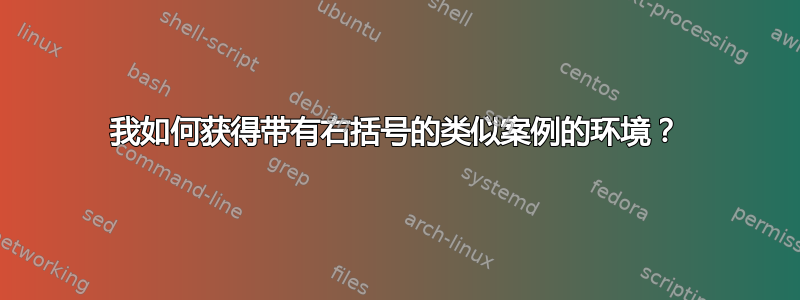
我想要像这样的括号,并且我尝试过了...也许我在 LaTeX 中尝试的方式是错误的?
LaTeX 代码:
\documentclass[a4paper,10pt]{scrartcl}
\usepackage{cancel}%fürs durchstreichen im mathemodus
\usepackage[b]{esvect}
\usepackage[latin1]{inputenc} % Anpassung des Zeichensatzs (Sonderzeichen)
\usepackage[leqno]{mathtools}
\usepackage{unicode-math}
\usepackage{polyglossia}
\usepackage{caption}
\usepackage{subcaption}
\begin{document}
\begin{rcases}
\begin{aligned}
\begin{itemize}
\item g \parallel E \;:\;\text{Abstand} d \neq 0
\item g \subset E \;:\;\text{Abstand} d = 0
\end{itemize}
\end{aligned}
\end{rcases}\Rightarrow \begin{rcases}
E: \langle \vv{n},\vv{r}-\vv{r}_0 \rangle = 0\\ g: \vv{r}(t)=\vv{r}_1+t\vv{a}, \; t \in R
\end{rcases}\Rightarrow \text{Skalarprodukt:} \langle \vv{n},\vv{a} \rangle \\
答案1
这只是一次快速而粗略的尝试。您使用哪种引擎(我问这个问题是因为您加载了inputenc(通常用于非 unicode,因此pdfLaTeX)和unicode-math(通常用于 unicode,因此LuaLaTeX或XeLaTeX)?我不确定您是否要使用箭头⇒。它们不是在图像中看到的,而是在您的源代码中看到的。
\documentclass[a4paper,10pt]{scrartcl}
\usepackage{cancel}%fürs durchstreichen im mathemodus
\usepackage[b]{esvect}
\usepackage{fontspec}%new
%\usepackage[latin1]{inputenc} % Anpassung des Zeichensatzs (Sonderzeichen)
\usepackage[leqno]{mathtools}
\usepackage{unicode-math}%I guess this does not fit to inputenc
\usepackage{polyglossia}
\usepackage{caption}
\usepackage{subcaption}
\usepackage{dsfont}%new for blackboard bold R in Latin Modern.
\newcommand{\bulletspace}{\bullet\hspace{0.5ex}}%new
\DeclarePairedDelimiterX\innerprod[2]{\langle}{\rangle}{#1,#2}%new. This makes stuff easier. You already loaded mathtools.
\begin{document}
\begin{align*}
\begin{rcases}
\parbox[c]{10.7em}{
%You may work with the itememize as an alternative.
%\begin{itemize}
%\item
$\bulletspace g \parallel E \colon\text{Abstand } d \neq 0$\\
%\item
$\bulletspace g \subset E\colon \text{Abstand } d = 0$
%\end{itemize}
}
\end{rcases}
\Rightarrow%This is not shown in image
\begin{rcases}
\parbox[c]{11.5em}{
$E\colon \innerprod{\vv{n}}{\vv{r}-\vv{r}_0} = 0$\\
$g\colon \vv{r}(t)=\vv{r}_1+t\vv{a}, \; t \in \mathds R $ % you might want to use a different font for the real numbers like \mathbf R or \BbbR or ℝ
}
\end{rcases}
\Rightarrow%This is not shown in image
\parbox[c]{7em}{
{Skalarprodukt:} \\
$\innerprod{\vv{n}}{\vv{a}}=0 $
}
\end{align*}
\end{document}
答案2
这是一个解决方案,它设置了一个array名为 的专用环境rarray。它使用 的两个实例rarray和一个 的实例array。(附言:该array环境非常基础,但也非常灵活和强大。)
\documentclass{article}
\usepackage{array,amsmath,amssymb}
\usepackage[normalem]{ulem} % for \uline macro
\newcolumntype{L}{>{\displaystyle}l} % automatic display-style mode
\newenvironment{rarray}{%
\left.\begin{array}{L @{{}:{}} L @{} }}{%
\end{array}\right\} }
\usepackage{sectsty}
\subsectionfont{\normalsize\mdseries\noindent\uline} % optional
\begin{document}
\setcounter{section}{3}
\setcounter{subsection}{9}
\subsection{Lagebeziehungen von einer Gerade und \dots}
\[
\renewcommand\arraystretch{1.25}
\begin{rarray}
\bullet\ g\parallel E & \text{Abstand $d\ne0$} \\
\bullet\ g<E & \text{Abstand $d=0$} % g<E ??
\end{rarray}
\begin{rarray}
E & \langle \vec{n},\vec{r}-\vec{r}_0 \rangle\\
g & \vec{r}(t)=\vec{r}_1+t\cdot\vec{a},\ t\in\mathbb{R}
\end{rarray}
\begin{array}{c}
\text{Skalarprodukt:}\\
\langle\vec{n},\vec{a}\rangle=0
\end{array}
\]
\end{document}




